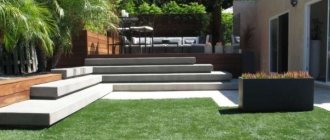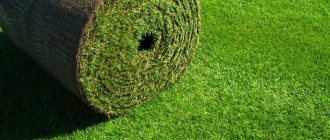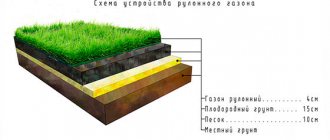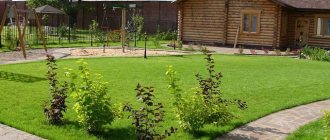Those who want to improve the territory in a short time, without sowing grass and tediously waiting for them to grow, should give preference to a rolled lawn: 1-2 days - and your site will not be a dull wasteland, but a beautiful green lawn!
Today, on private lands, the lawn is taking over more and more territory from the beds. And for good reason. After all, a dacha is intended not only for hard work, but also for relaxation. But sowing and growing lawn grass is not an easy and painstaking task. Laying rolled lawn helps speed up and simplify the process. Anastasia Gordikova, landscape designer of the Hedera Art Studio, spoke about the intricacies of working with him.
Anastasia Gordikova is a graduate of the Kyiv College of Architecture and Design, as well as the National University of Bioresources and Environmental Management of Ukraine. She has been working as a landscape designer, gardener and gardening consultant for more than 5 years. For her, a garden is not just a few trees and bushes planted in a certain pattern, it is a picture painted on the canvas of nature.
+380979424238, www.hedera.com.ua
Laying rolled lawn yourself is a risky business. If something goes wrong during installation, you risk saying goodbye to a tidy sum, because rolled herbs are not cheap. Sometimes owners of country houses unknowingly turn to builders to lay such a lawn (they, as a rule, charge inexpensively and assure that there is nothing complicated in laying the rolls). At first glance, this is true. But the trouble is that builders are not aware of all the intricacies of the “roll”. They may roll it out onto an unleveled surface, stones or peat, or they may not water it, and such a lawn will simply burn in the sun. If you invite landscape designers to the site, then the risk of losing the lawn is possible only due to lack of care for it.
Advantages and disadvantages of rolled lawn
Rolled lawn has a number of advantages. Although it has one drawback, it is quite significant. Therefore, every gardener is free to choose for himself which lawn to give preference to.
Advantages of rolled lawn:
- with its help you can improve the territory in just a few days;
- it can grow even on clay soils, since its turf is about 3 cm thick;
- You can plant trees in any area, even on a slope;
- almost no weeds grow through the dense turf;
- Rolled lawn requires less maintenance than seeded lawn;
- within 3 days after installation you will be able to run, jump and sunbathe on your lawn, while such activity will only be available in a month or two when sowing.
Disadvantage of rolled lawn:
- high price.
How much water is needed: consumption rates per m2
The amount of water per square meter of lawn area is determined by the time of year, the composition of the soil and the type of lawn vegetation. Based on the approved standards for central Russia, 1 m2 of lawn plantings consume 4-6 liters of water per irrigation, of which there can be several per day.
Features of calculation by season
The given standards are adjusted according to the seasons of the year. In the heat of summer, the irrigation rate on light sandy soils increases to 20-40 liters of water per square meter, but not at once, but over the course of a whole day. On loamy soils with a moderate rate of moisture filtration, 12-13 l/m2 are consumed per watering three times a week. Clay soils with low water filtration rates require watering once a week, using 35-40 l/m2.
The norm for spring watering is 15 liters of water per m2 of newly planted lawn. Further, to maintain the proper level of humidity, while it is still cool and the ground is saturated with melt water, 25 l/m2 per week is enough.
In autumn, during dry weather, water the lawn once a week, spending 10-15 l/m2. The volume of water for irrigation is gradually reduced and is carried out every 10-14 days. The last watering occurs at the end of September - beginning of October. Experienced gardeners combine autumn moisture with the application of complex mineral fertilizing.
The principle of growing rolled lawn
Rolls of lawn grass, which are used for arranging lawns, are grown in two ways. In the first case, “ribbons” of lawn grow on a mesh; in the second, the dense turf itself serves as the basis.
First way . The soil is treated with herbicides, milled, leveled and rolled, after which a net is laid on it. Next, lawn grass is sown and a layer of soil is poured (about 2 cm). Crops are watered daily, preventing the soil from drying out. Subsequently, the roots of the sprouted grass are intertwined with the mesh, and a complete fabric is obtained. Thanks to this, the layer of grass can be easily rolled up.
Second way. A lawn without a mesh is grown according to the same principle as the first method. But it forms such a dense turf that it does not break up into fragments. Such a lawn is cut using special equipment that automatically rolls the “ribbons” into rolls.
Typically, it takes 1.5-2 years to grow a rolled lawn. During this time, the grass grows such a volume of the root system, thanks to which it is securely held in the canvases.
The thickness of the turf can vary depending on what the lawn was grown on. If it grew on peat, then its thickness will be about 1 cm. Such canvases can tear. If the grass grew on black soil, then the thickness of the turf will be 1-2 cm or even more. It is also interesting that the lawn on black soil is so self-sufficient that if it is watered, it can even grow on asphalt.
The grass you buy should be cut and the rolls cut equally. Do not buy lawn if it rains - in this case, the grass in the lawn fields begins to hurt. It's better to postpone the purchase for a few days.
All grasses that make up a lawn are different. Some develop very quickly, others are resistant to trampling, and others are durable. Therefore, it is necessary to buy the grass mixture. If the lawn consists of one type of grass, after some time it will become loose. The optimal grass mixture composition for a rolled lawn is: 50-60% bluegrass, 25% fescue and 15% ryegrass.
Errors
When watering a rolled lawn, summer residents, especially inexperienced ones, are not immune to mistakes. The most common ones can be easily corrected or avoided altogether with a little more care:
- Excessive or insufficient watering . The first leads to the formation of puddles, acidification of the soil and death of the lawn. The second is that the grass does not receive enough moisture and nutrients, which leads to dryness and wilting of the lawn. In both cases, you need to adhere to the watering norm, taking into account climatic conditions and soil composition.
- Irrigation in hot sunny weather in the afternoon - water evaporates quickly and does not have time to saturate the soil and plants. It is better to move the watering time to the morning or evening.
- Frequent and small waterings are harmful - the soil does not have time to fully moisten, the roots begin to grow over the surface. This mode will only be useful for restoring a dried out lawn.
- Watering with a direct stream from a hose prevents nutrients from being retained in the soil. It is better to use special attachments - sprinklers.
How to prepare the area for laying a lawn
Lawn grass rolled into rolls cannot be stored in this state for a long time: it begins to rot very quickly. Therefore, our studio specialists come to the site a few days before the start of work to assess the condition of the soil and plan actions. This is especially true for large garden areas, which take a lot of time to cover.
Step 1. The area is first cleared of weeds, stones and debris. Very often the soil has to be treated with continuous herbicides (for example, Roundup).
Step 2. Next, the area is leveled with a rake. If the soil is heavy, add a layer of chernozem 5-10 cm high. The clay is first “covered” with sand (for drainage), and then with fertile soil (layer thickness 10-20 cm). If the soil, on the contrary, is sandy, clay is poured onto it in a layer of 5 cm or agrotextiles folded in 2 layers are laid, and only after that they are covered with a layer of chernozem.
In an area with sandy soil, before laying the lawn, you must pour a layer of clay on it or put geotextiles on it. Otherwise, the water will go into the soil too quickly, and the grass will have to be watered very often. The water consumption in this case will be colossal.
Step 3. At the next stage, roll the soil with a roller and check whether the surface is level. If necessary, add soil to the recesses and depressions. The soil is filled up to the lower edge of the curb so that after laying the grass stand is higher than the path. This will make it easier to mow with a lawn mower.
To check how well the soil surface is leveled, the rolled soil can be watered. If there are voids in the area, they will show themselves: in these places the soil will sag.
Scheme
A medium to small area of lawn can be watered with a regular garden watering can. A garden hose without a nozzle, but with the neck pinched with your finger, will speed up the process. However, the following devices will help significantly facilitate care:
- a perforated hose with many holes along its entire length moves across the lawn and covers a large area;
- sprinkler - a nozzle on a hose that converts a strong stream of water into small drops that do not erode the soil surface;
- a circular sprinkler resembles a miniature fountain; a set of several devices is suitable for watering a fairly large area;
- The rotating sprinkler allows you to regulate the pressure of the jets and adjust the watering distance.
Automatic lawn irrigation systems are designed individually, based on the irrigation area, soil composition, and plant type. May have varying degrees of complexity and autonomy. Such systems are installed by professionals even before the lawn itself is laid.
Rules for laying rolled lawn
As a rule, by the time the lawn is laid, the area has already been prepared. This means that the grass is laid on the same day that the rolls are delivered to customers. By what principles do we lay a lawn?
Rule 1. Rolled lawn should be rolled out in strips in one direction, adhering to a checkerboard pattern so that the transverse sections of adjacent strips are not located on the same line.
Rule 2. The edges of the strips should be tightly adjacent to each other. No padding or overlapping layers are allowed.
Rule 3. After laying, the lawn should be “rolled” with a roller and watered thoroughly. Adequate moisture will help the grass establish itself as quickly as possible.
What to do if you didn’t have time to lay all the rolled lawn?
It also happens that it is physically impossible to cover the entire territory in one day. What to do in such a situation with the grass left in rolls, because it quickly deteriorates? Transfer the remaining rolls of lawn grass to the shade or roll them out in an empty area and water them - this will extend the life of the grass for some time.
Please note that laying the rolled lawn should only be done after installing the irrigation system!
Scarification
Over time, the vegetation loses its attractiveness. Despite repeated mowing, fertilizing and raking, the remains of dead plants accumulate on the surface, leaving the lawn in a very unsightly appearance. Scarification is a method of removing moss and thatch from the lawn, thereby providing air and light to the lower parts of the plants. Thanks to this care, the applied fertilizers are more effectively distributed over the surface and reach the root system of the cereals faster.
Scarification is recommended to be carried out no more than twice a year:
- in autumn, promoting the formation of dense turf, increasing the thickness of the covering;
- in early spring, preventing the growth of moss and decay after a warm winter.
In order to properly perform scarification, it is necessary to make vertical cuts along the dense layer of turf. The best results can be achieved if the cuts are made alternately: one cut line along, the next one across.
Preparing the lawn for the procedure includes several stages:
- mowing the lawn (grass height should not exceed three centimeters);
- watering the canvas;
- thorough combing with a rake.
In order to carry out scarification, you need to make longitudinal cuts on the grass cloth along the compacted turf layer.
There are several types of devices that cope with the task perfectly:
- powerful gasoline units capable of processing large areas;
- electrical for home use;
- homemade mechanical;
- shoe attachments.
An important criterion that determines the quality of work is the depth of the turf cut, which can be obtained by working with expensive gasoline and electric devices.
How to care for rolled lawn after installation?
If you want your lawn to be perfect, it needs to be maintained properly. Immediately after laying the grass, water it - otherwise it will simply dry out.
the time of the first mowing , because a lot here depends on how tall the grass was in the rolls. Sometimes the lawn has to be mowed after just a couple of days, and sometimes after a week. In the future, it is recommended to mow the lawn once every 5 days.
As for fertilizers , they are applied once a month - from the beginning of spring until August. It is best to use a special fertilizer for the lawn marked “spring-summer” (according to the instructions). Next, you need to take a break, and at the end of October, feed the grass again, but this time with a special autumn fertilizer for the lawn without nitrogen.
Weeds rarely grow through a rolled lawn, but the most “malicious” ones still manage to make their way to the light. The good news is that there are not too many of them, and getting rid of them is therefore much easier.
No matter what part of the territory you allocate for a lawn, it will look exceptionally good. Evenly cut grass unites all areas and objects of the garden into a single whole. So, if you have the opportunity to organize a green “island” on your site, be sure to do it - you won’t regret it.
Weed removal
When growing a lawn, a special mesh is sometimes used. The mesh allows the roots to intertwine more tightly and serves as a barrier to weeds. If your lawn has a mesh, then the first year there may be no weeds. But sometimes they still make their way through turf of any density.
Herbicides are used to kill weeds. They spray the surface of the weed. The root must be removed using a special spatula. However, it can harm already strong, dense turf. Therefore, you can use it on a young lawn, but on older lawns it is better to use herbicides.
The procedure is carried out in dry and windless weather. To prevent substances from getting onto the lawn. Conducted before haircut. Should not be carried out before rain or during severe drought.
AUTUMN
At the beginning of September, fertilize the lawn: potassium - 20-30 g per m² phosphorus - 5-10 g per m², no need to add nitrogen.
The last mowing of the lawn should be carried out in September 20-30 days before the onset of stable frosts. If the lawn is not mowed, then fungi will grow under the dying greenery and, as a result, disease will begin to develop.
By winter, it is necessary to remove leaves from the lawn, as they help retain moisture in the immediate vicinity of the lawn, which in turn causes fungal diseases.











